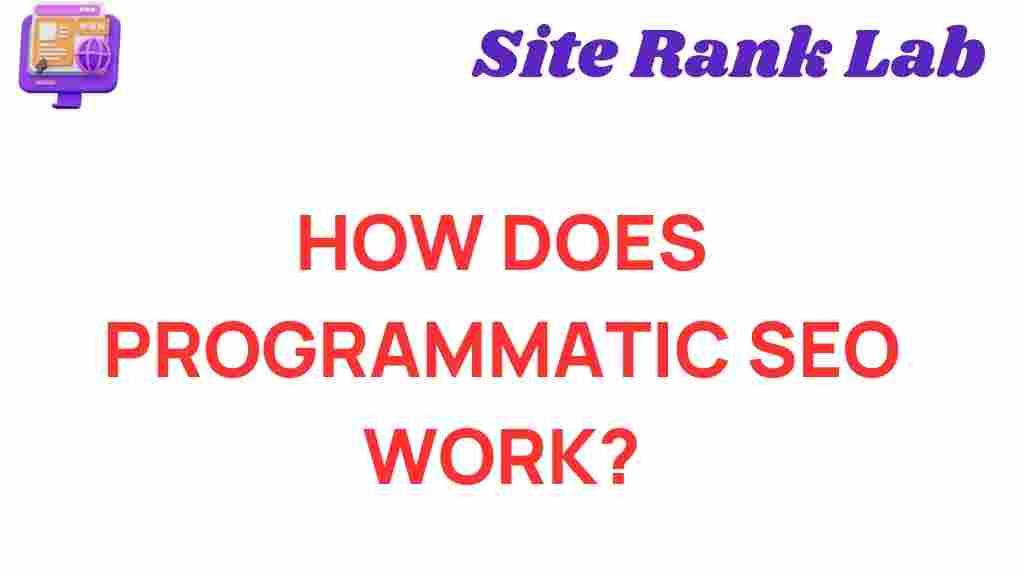Unlocking the Secrets: How Programmatic SEO Works for Your Business
In the ever-evolving landscape of digital marketing, businesses are constantly seeking innovative approaches to enhance their online visibility and drive website traffic. One such approach that has gained traction in recent years is programmatic SEO. This method leverages algorithmic strategies and content automation to optimize websites at scale, ensuring that businesses reach their target audience effectively. In this article, we will explore the intricacies of programmatic SEO, how it works, and how it can transform your digital marketing efforts.
Understanding Programmatic SEO
Programmatic SEO refers to the use of automated processes and data-driven methods to improve search engine optimization (SEO) efforts. Unlike traditional SEO, which often relies heavily on manual optimization techniques, programmatic SEO utilizes algorithms and software to generate content, optimize keywords, and analyze data at a much larger scale. This approach allows businesses to create a significant number of optimized web pages efficiently and effectively.
The Benefits of Programmatic SEO
Integrating programmatic SEO into your digital marketing strategy can provide numerous benefits:
- Scalability: Quickly generate and optimize large volumes of content.
- Efficiency: Save time and resources by automating repetitive tasks.
- Data-Driven Insights: Leverage analytics to refine strategies based on performance metrics.
- Increased Visibility: Enhance your website’s presence across various search engines.
- Cost-Effectiveness: Reduce the need for extensive manual SEO work, lowering overall costs.
How to Implement Programmatic SEO
To successfully implement programmatic SEO for your business, follow these step-by-step guidelines:
Step 1: Identify Your Goals
Before diving into programmatic SEO, clearly define your objectives. Are you looking to increase website traffic, improve conversion rates, or enhance brand visibility? Setting specific goals will guide your strategy.
Step 2: Conduct Keyword Research
Effective programmatic SEO starts with comprehensive keyword research. Use tools like Google Keyword Planner or SEMrush to identify relevant keywords within your niche. Focus on long-tail keywords as they often have lower competition and higher conversion potential.
Step 3: Leverage Content Automation Tools
Invest in content automation tools that can help you generate optimized content based on your target keywords. These tools can create articles, product descriptions, and landing pages tailored to your audience’s needs.
Step 4: Optimize Your Website Structure
A well-structured website is crucial for effective SEO. Ensure that your website is easy to navigate, with clear categories and subcategories. This organization helps search engines crawl your site efficiently.
Step 5: Implement Algorithmic Strategies
Utilize algorithmic strategies to enhance your SEO efforts. This includes:
- Dynamic Content Generation: Create content that adapts based on user behavior and preferences.
- Schema Markup: Use schema to help search engines understand your content better.
- Predictive Analytics: Analyze user data to anticipate trends and optimize content accordingly.
Step 6: Monitor Performance Metrics
Regularly monitor the performance of your programmatic SEO efforts. Use tools like Google Analytics to track website traffic, user engagement, and conversion rates. Analyze this data to refine your strategy continuously.
Troubleshooting Common Issues in Programmatic SEO
While programmatic SEO can be incredibly effective, businesses may encounter challenges along the way. Here are some common issues and their solutions:
Issue 1: Low-Quality Content
Solution: Ensure that your content automation tools are set to generate high-quality, relevant content. Regularly review and edit automated content to maintain quality standards.
Issue 2: Poor Keyword Targeting
Solution: Revisit your keyword research process. Focus on understanding user intent and refining your target keywords accordingly.
Issue 3: Technical SEO Issues
Solution: Conduct regular technical audits of your website to identify and fix issues related to site speed, mobile-friendliness, and indexing.
Issue 4: Inadequate Analytics Tracking
Solution: Implement robust analytics tracking. Ensure that you are capturing all relevant data to make informed decisions based on performance metrics.
Conclusion
In conclusion, programmatic SEO offers businesses a powerful means to enhance their search engine optimization efforts through algorithmic strategies and content automation. By leveraging data-driven methods, companies can efficiently generate optimized content, increase website traffic, and ultimately drive growth. While there may be challenges along the way, the benefits of programmatic SEO far outweigh the hurdles, making it an essential component of any digital marketing strategy.
As the digital landscape continues to evolve, those who embrace programmatic SEO will be well-positioned to stay ahead of the competition. For more insights on digital marketing and SEO strategies, visit our blog. If you’re looking for additional resources, check out this insightful article on SEO best practices.
This article is in the category SEO and created by SiteRankLab Team
